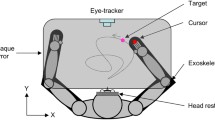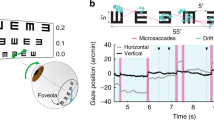Abstract
Movement of the body, head, or eyes with respect to the world creates one of the most common yet complex situations in which the visuomotor system must localize objects. In this situation, vestibular, proprioceptive, and extra-retinal information contribute to accurate visuomotor control. The utility of retinal motion information, on the other hand, is questionable, since a single pattern of retinal motion can be produced by any number of head or eye movements. Here we investigated whether retinal motion during a smooth pursuit eye movement contributes to visuomotor control. When subjects pursued a moving object with their eyes and reached to the remembered location of a separate stationary target, the presence of a moving background significantly altered the endpoints of their reaching movements. A background that moved with the pursuit, creating a retinally stationary image (no retinal slip), caused the endpoints of the reaching movements to deviate in the direction of pursuit, overshooting the target. A physically stationary background pattern, however, producing retinal image motion opposite to the direction of pursuit, caused reaching movements to become more accurate. The results indicate that background retinal motion is used by the visuomotor system in the control of visually guided action.



Similar content being viewed by others
References
Admiraal MA, Keijsers NL, Gielen CCAM (2003) Interaction between gaze and pointing toward remembered visual targets. J Neurophysiol 90:2136–2148
Andersen RA, Buneo CA (2002) Intentional maps in posterior parietal cortex. Annu Rev Neurosci 25:189–220
Andersen RA, Snyder LH, Bradley DC, Xing J (1997) Multimodal representation of space in the posterior parietal cortex and its use in planning movements. Annu Rev Neurosci 20:303–330
Ashida H (2004) Action-specific extrapolation of target motion in human visual system. Neuropsychologia 42:1515–1524
Batista AP, Buneo CA, Snyder LH, Andersen RA (1999) Reach plans in eye-centered coordinates. Science 285:257–260
Blouin J, Gauthier GM, van Donkelaar P, Vercher JL (1995) Encoding the position of a flashed visual target after passive body rotations. Neuroreport 6:1165–1168
Blouin J, Gauthier GM, Vercher JL, Cole J (1996) The relative contribution of retinal and extraretinal signals in determining the accuracy of reaching movements in normal subjects and a deafferented patient. Exp Brain Res 109:148–153
Bock O (1986) Contribution of retinal versus extraretinal signals towards visual localization in goal-directed movements. Exp Brain Res 64:476–482
Brenner E, Smeets JBJ (1997) Fast responses of the human hand to changes in target position. J Motor Behav 29:297–310
Bridgeman B (1986) Multiple sources of outflow in processing spatial information. Acta Psychol (Amst) 63:35–48
Bridgeman B, Stark L (1991) Ocular proprioception and efference copy in registering visual direction. Vision Res 31:1903–1913
Buneo CA, Jarvis MR, Batista AP, Andersen RA (2002) Direct visuomotor transformations for reaching. Nature 416:632–636
Collewijn H, Tamminga EP (1984) Human smooth and saccadic eye movements during voluntary pursuit of different target motions on different backgrounds. J Physiol 351:217–250
De Valois RL, De Valois KK (1991) Vernier acuity with stationary moving Gabors. Vision Res 31:1619–1626
Desmurget M, Pelisson D, Rossetti Y, Prablanc C (1998) From eye to hand: planning goal-directed movements. Neurosci Biobehav R 22:761–788
Durant S, Johnston A (2004) Temporal dependence of local motion induced shifts in perceived position. Vision Res 44:357–366
Edwards M, Badcock DR (2003) Motion distorts perceived depth. Vision Res 43:1799–1804
Enright JT (1995) The non-visual impact of eye orientation on eye-hand coordination. Vision Res 35:1611–1618
Fu YX, Shen Y, Dan Y (2001) Motion-induced perceptual extrapolation of blurred visual targets. J Neurosci 21:RC172
Fu YX, Shen Y, Gao H, Dan Y (2004) Asymmetry in visual cortical circuits underlying motion-induced perceptual mislocalization. J Neurosci 24:2165–2171
Gauthier GM, Nommay D, Vercher JL (1990) The role of ocular muscle proprioception in visual localization of targets. Science 249:58–61
Goltz HC, Whitney D (2004) The influence of background motion on smooth pursuit: separation matters. J Vision 4:649
Hallett PE, Lightstone AD (1976) Saccadic eye movements towards stimuli triggered by prior saccades. Vision Res 16:99–106
Hansen RM, Skavenski AA (1985) Accuracy of spatial localizations near the time of saccadic eye movements. Vision Res 25:1077–1082
Hayes A (2000) Apparent position governs contour-element binding by the visual system. P Roy Soc Lond B Bio 267:1341–1345
Henriques DY, Klier EM, Smith MA, Lowy D, Crawford JD (1998) Gaze-centered remapping of remembered visual space in an open-loop pointing task. J Neurosci 18:1583–1594
Honda H (1990) The extraretinal signal from the pursuit-eye-movement system: its role in the perceptual and the egocentric localization systems. Percept Psychophys 48:509–515
Howard IP, Marton C (1992) Visual pursuit over textured backgrounds in different depth planes. Exp Brain Res 90:625–629
Jeannerod M (1988) The neural and behavioural organization of goal-directed movements. Clarendon, Oxford
Keller EL, Khan NS (1986) Smooth-pursuit initiation in the presence of a textured background in monkey. Vision Res 26:943–955
Leibowitz HW, Post RB, Sheehy JB (1986) Efference, perceived movement, and illusory displacement. Acta Psychol (Amst) 63:23–34
Lindner A, Schwarz U, Ilg UJ (2001) Cancellation of self-induced retinal image motion during smooth pursuit eye movements. Vision Res 41:1685–1694
Ma-Wyatt A, McGraw PV (2003) Illusory positional shifts affect both perception and action. J Vision 3:122
Masson G, Proteau L, Mestre DR (1995) Effects of stationary and moving textured backgrounds on the visuo-oculo-manual tracking in humans. Vision Res 35:837–852
McGraw PV, Whitaker D, Skillen J, Chung ST (2002) Motion adaptation distorts perceived visual position. Curr Biol 12:2042–2047
Medendorp WP, Crawford JD (2002) Visuospatial updating of reaching targets in near and far space. Neuroreport 13:633–636
Mohrmann H, Thier P (1995) The influence of structured visual backgrounds on smooth-pursuit initiation, steady-state pursuit and smooth-pursuit termination. Biol Cybern 73:83–93
Mohrmann-Lendla H, Fleischer AG (1991) The effect of a moving background on aimed hand movements. Ergonomics 34:353–364
Mussap AJ, Prins N (2002) On the perceived location of global motion. Vision Res 42:761–769
Neggers SF, Bekkering H (2001) Gaze anchoring to a pointing target is present during the entire pointing movement and is driven by a non-visual signal. J Neurophysiol 86:961–970
Niemann T, Hoffmann KP (1997) The influence of stationary and moving textured backgrounds on smooth-pursuit initiation and steady state pursuit in humans. Exp Brain Res 115:531–540
Nishida S, Johnston A (1999) Influence of motion signals on the perceived position of spatial pattern. Nature 397:610–612
Post RB, Shupert CL, Leibowitz HW (1984) Implications of OKN suppression by smooth pursuit for induced motion. Percept Psychophys 36:493–498
Pouget A, Ducom JC, Torri J, Bavelier D (2002) Multisensory spatial representations in eye-centered coordinates for reaching. Cognition 83:B1–11
Ramachandran VS, Anstis SM (1990) Illusory displacement of equiluminous kinetic edges. Perception 19:611–616
Schwarz U, Ilg UJ (1999) Asymmetry in visual motion processing. Neuroreport 10:2477–2480
Schweigart G, Mergner T, Barnes GR (2003) Object motion perception is shaped by the motor control mechanism of ocular pursuit. Exp Brain Res 148:350–365 (Epub 2002 Nov 2020)
Shim WM, Cavanagh P (2004) The motion-induced position shift depends on the perceived direction of bistable quartet motion. Vision Res 44:2393–2401
Snowden RJ (1998) Shifts in perceived position following adaptation to visual motion. Curr Biol 8:1343–1345
Soechting JF, Engel KC, Flanders M (2001) The Duncker Illusion and Eye-Hand Coordination. J Neurophysiol 85:843–854
van Donkelaar P, Staub J (2000) Eye-hand coordination to visual versus remembered targets. Exp Brain Res 133:414–418
Watanabe K, Sato TR, Shimojo S (2003) Perceived shifts of flashed stimuli by visible and invisible object motion. Perception 32:545-559
Whitaker D, McGraw PV, Pearson S (1999) Non-veridical size perception of expanding and contracting objects. Vision Res 39:2999–3009
Whitney D (2002) The influence of visual motion on perceived position. Trends Cogn Sci 6:211–216
Whitney D, Cavanagh P (2000) Motion distorts visual space: shifting the perceived position of remote stationary objects. Nat Neurosci 3:954–959
Whitney D, Goltz HC, Thomas CG, Gati JS, Menon RS, Goodale MA (2003a) Flexible retinotopy: motion-dependent position coding in the visual cortex. Science 302:878–881
Whitney D, Westwood DA, Goodale MA (2003b) The influence of visual motion on fast reaching movements to a stationary object. Nature 423:869–873
Yamagishi N, Anderson SJ, Ashida H (2001) Evidence for dissociation between the perceptual and visuomotor systems in humans. P Roy Soc Lond B Bio 268:973–977
Yee RD, Daniels SA, Jones OW, Baloh RW, Honrubia V (1983) Effects of an optokinetic background on pursuit eye movements. Invest Ophth Vis Sci 24:1115–1122
Acknowledgements
Thanks to Herb Goltz. This work was partially supported by NEI F32 EY013899 to D.W., and a CIHR grant to M.A.G.
Author information
Authors and Affiliations
Corresponding author
Rights and permissions
About this article
Cite this article
Whitney, D., Goodale, M.A. Visual motion due to eye movements helps guide the hand. Exp Brain Res 162, 394–400 (2005). https://doi.org/10.1007/s00221-004-2154-0
Received:
Accepted:
Published:
Issue Date:
DOI: https://doi.org/10.1007/s00221-004-2154-0




